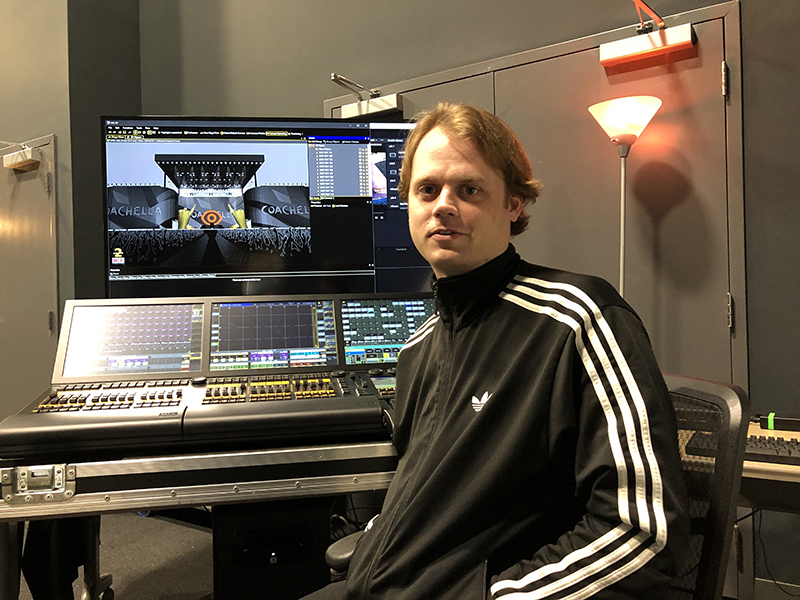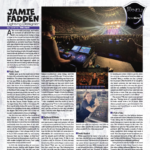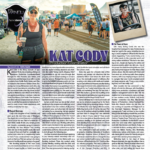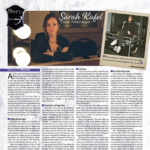
This young Minneapolis-based designer keeps surviving trials-by-fire.
In our continuing quest to introduce our readers to some industry friends we feel may be household names in the future, we introduce the latest in our next generation of potential Parnelli winner series, LD Max McDougall.
I caught up with Max this week, in between shows at Coachella, where he was asked to look after Puerto Rican Reggaetón act Bad Bunny. The artist had played the first weekend during the 5:30 p.m. slot on the main stage and was returning to the same stage the next weekend. During the first performance, Max did not have enough programming time that day to pixel map the band’s video to the lights as well as add in all kinds of cool effects from the Claypaky B-Eyes. So he came to the Legacy Production Group office, across the Mississippi River from his St. Paul home, to borrow their grandMA2 console and visualizer to make next week’s performance better.
“I had never worked with this artist before, and as is with the first show you do with any artist new to you, you’re nervous and not sure how well you’ll do. But management told me it looked great. I went back to look at the stream on the internet and it looked better than I originally thought.” This is the kind of guy Max is. It’s not the fact that he cares about his gig (he does), but more along the lines that Max is always tinkering with something to make it better — whether it’s a piece of software or a bunch of antiquated gear brought to life for a project. Much of this goes back to his love of technology of all sorts. Heck, Max is one of those rare people that still shoots stills with film.
Making the Old Screens Dance
Hailing from Fergus Falls, MN, Max made the 175-mile move to St Paul to study audio engineering on his own when he was 17. “While I was at school, I started messing around with more video software on my laptop, then getting into audio. While underage, I started going to this club and noticed they were always replaying the same media clips. One day I asked if I could plug in my laptop. After that, I came back repeatedly to do techno nights for a little cash and some drinks, while at the same time doing more gallery video/light installations around town.”
Around the same time, Max started collecting old electronics, including TV sets. “I was collecting standard-def products and would make these weird video installations. This was around the time many young people were getting involved in the underground scene. A lot of the promoters I was working with had been throwing parties for 15 or 20 years at this point. The techno scene in particular had a pretty diverse age group in attendance. I would show up and make a wall of TVs on the dance floor. I’d use color from the old sets to pump light with the beat of the music. I guess that’s what got me interested in lighting.”
He had done some work with community theater, and when he was 21, he landed a job at the Mystic Lake Casino outside town. “While there, I found an MA Scancommander console buried in the shop, and started using it on shows around the casino. Eventually, I found one for a grand in a pawn shop, and bought it.”
This led to him to doing more techno parties and renting lights from a local vendor in town, Ruehling Associates. “I was also doing shows at places like Epic, formally known as quest, formally known as Glam Slam, with Matt Guertin who worked with me on both Aoki and Bad Bunny for V-Squared/Xite.” People caught wind of the techno scene, and what Max was doing. He started getting asked to do some corporate shows. “I really started getting better at lighting by doing larger corporate shows and learning how to properly light for cameras and make scenic look nice. I spent lots of time during boring general sessions learning how to program advanced features on the grandMA2.”
Getting Signal to Old Hardware
Bands were hitting him up to light their shows at the First Ave Nightclub. He left the casino and ventured into doing his own thing. “I like hardware and figuring out how I can get signal to it. I like to maximize the value of old antiquated gear that nobody else wants. We would set up shows in grungy old warehouses — the vibe fit the aesthetic for what we were doing in the underground techno scene.”
A few scant years ago, he got his first touring beak. He was introduced to creative director and VJ Vello Virkhaus from V-Squared Labs (now Xite). They were doing some work for Steve Aoki, the DJ and music producer. They had built a tough set that was hard to fit in and build every day. Max carried a minimal floor package, but also had a lot of custom LED products to run. He sat behind a visualizer and taught himself the grandMA2. The act played anywhere from 600 to 4,000-seat rooms. “It was a lot of set to fit in some of the smaller rooms. I would eventually get by on that tour. But before I did a single headline show with that rig, I was thrown into the fire with a gig at a festival with hundreds of lights. I remember calling up Arlo (local LD legend Paul Guthrie) and asking him what to do. He told me ‘You’ll be fine, the people there will help you.’ They did, and I survived.”
Max likes to have the ability to timecode some parts of his shows, but he states, “I like to feel the room out and adjust my lighting for it. I can’t really do that running full-on timecode. I mean, some shows even timecode the blinders.” He adds, “Some programmers spend more time building a macro than focusing on getting in looks for a show. I can take a whole morning at a gig writing macros and setting my board up, but in the end, I’ve learned I just wasted my morning. The basics are more important. But I still love to write crazy macros, though!”
In the winter of 2018, Max got a call from local production manager Paul Wichmann. An upcoming act named Tyler the Creator was looking for a new LD. Max’s name kept coming up from corporate clients to local guys as the man for the job. “Tyler wanted a theatrical show. The mandate called for a design with some big looks, but kept the scenery lit. Flash-and-trash did not interest him. When I met him, he was just looking for someone to answer his questions correctly. I guess I passed the audition.”
Hitting the Road
Max got a lighting rig from the Legacy Production Group and hit the road. “I was pretty green to touring still, but the camp said, ‘This is perfect. This is what we need.’” The tour went fine, as they played theaters. But then we got to festivals. I had to clone my small system to these monster rigs. I had to learn quick. But then we got to Coachella…and that was plain intimidating.”
He has been getting thrown into the fire a lot, but the LD doesn’t seem to get burned. He’s actually come to terms with his programming style. “The best thing is to never get stuck in your ways. Set up your desk thinking, ‘I know this is gonna work.’ Each artist has a few demands, such as a red cue here, a strobe hit there. You make sure those are nailed. But the most important thing I’ve learned from all these festival gigs is to prioritize your time and resources.”
He also considers networking to be key to his future. He meets other designers and feeds off their skills. He gets unexpected gigs at times. “I met Ben Dalgleish briefly at a festival. He looks after Post Malone.
Not long afterwards, I got a call from Ben to cover a couple gigs for him. It was a great experience. Now Tyler the Creator is working on some upcoming designs and bringing in some other designers. I’m looking forward to it, and all we can learn from each other.”
PLSN’s NextGen column, which we launched last month, focuses on the next generation of lighting designers, video directors, scenic designers and production staff worthy of being recognized, who may just become a household name in our biz one day. If you would like to submit a name for consideration, send it to nook@plsn.com.


